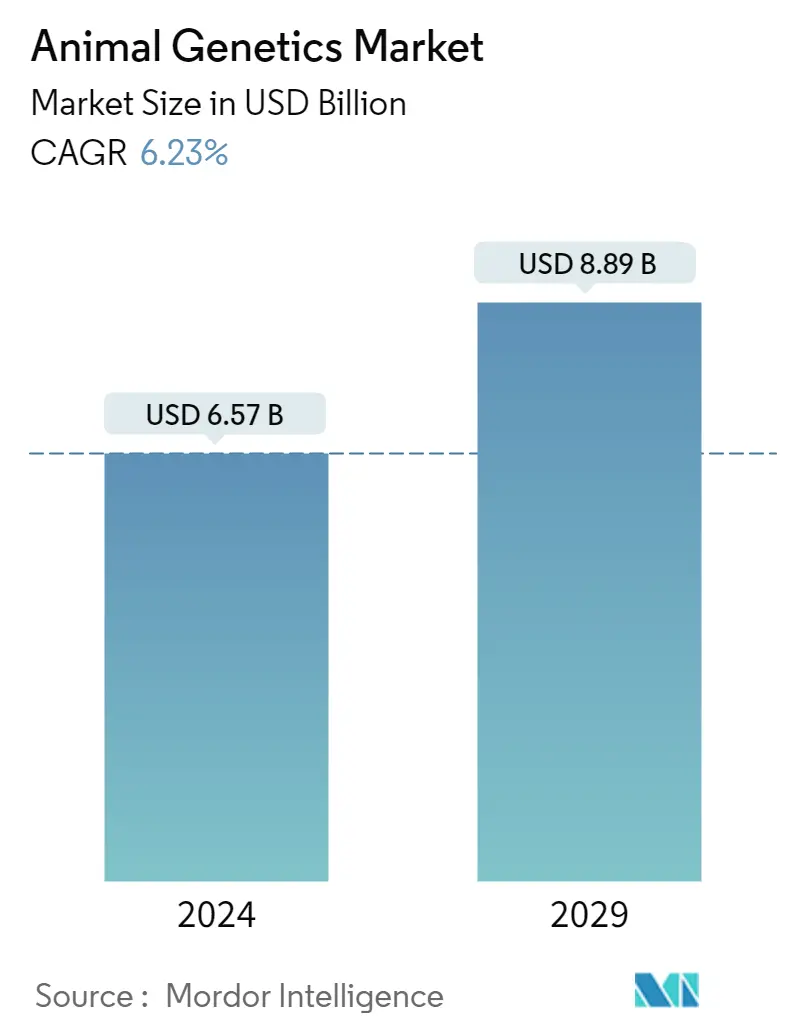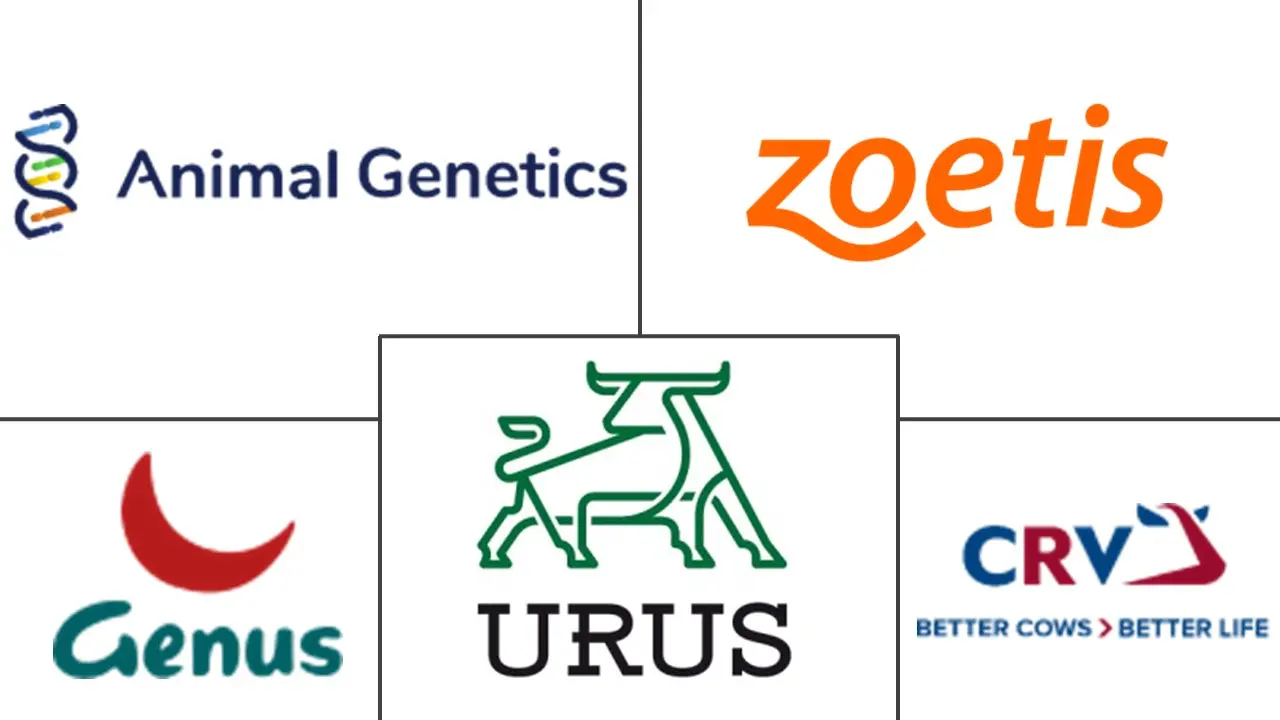Market Size of Animal Genetics Industry

| Study Period | 2021 - 2029 |
| Market Size (2024) | USD 6.57 Billion |
| Market Size (2029) | USD 8.89 Billion |
| CAGR (2024 - 2029) | 6.23 % |
| Fastest Growing Market | Asia-Pacific |
| Largest Market | North America |
Major Players
*Disclaimer: Major Players sorted in no particular order |
Animal Genetics Market Analysis
The Animal Genetics Market size is estimated at USD 6.57 billion in 2024, and is expected to reach USD 8.89 billion by 2029, growing at a CAGR of 6.23% during the forecast period (2024-2029).
Animal genetics aims to produce animals with the most desirable traits. The selection of traits for adaptability to a particular condition or disease resistance in an animal can be obtained through strategic breeding. A genetically modified cow may be able to produce more milk and can be less prone to common cattle diseases, such as bovine respiratory disease complex and clostridial disease, among others, effectively increasing the cattle raisers' overall profit. For instance, according to an article published by Elsevier, in December 2021, genetic selection for increased milk yield has been a key driver of dairy intensification leading to the development of highly specialized milk production systems, with increasing herd size and heavily relying on cereals and protein sources. Hence, this aspect of animal genetics has been widely recognized, which is predicted to result in the overall growth of the animal genetics market.
The rising initiative to educate on animal genetic testing is further expected to drive the growth of this market. For instance, in June 2020, the Veterinary Genetics Laboratory (VGL) at the UC Davis School of Veterinary Medicine launched an updated and advanced website along with several new tests for the veterinary community. In addition, in October 2021, Embark Veterinary, Inc. launched its DNA test for purebred dogs. The kit offers purebred owners unique, actionable health information to help determine diagnostic, monitoring, and treatment plans that can easily be shared with a veterinarian. Such initiatives will lead to increased adoption of genetic testing for animal health care, thereby driving the market growth. Other factors affecting the market's growth include increasing consumer demand for animal-derived protein and the growing adoption of advanced genetic technologies for larger-scale production and quality breeding.
Hence, due to the factors mentioned above, the animal genetics market is expected to grow significantly over the forecast period. However, the lack of skilled professionals to carry out genetics-related techniques in veterinary research is expected to hamper the market's growth over the forecast period.
Animal Genetics Industry Segmentation
The animal genetics market includes all animal genetic tests and services based on genetic engineering techniques. The most critical application of animal genetics is in animal breeding, wherein particular traits of animals are exploited for human interests.
The Animal Genetics Market is Segmented by Animal (Poultry, Porcine, Canine, and Other Animals), Animal Genetic Testing Services (DNA Typing, Genetic Trait Tests, and Other Animal Genetic Testings), and Geography (North America (United States, Canada, and Mexico), Europe (Germany, United Kingdom, France, Italy, Spain, and Rest of Europe), Asia-Pacific (China, Japan, India, Australia, South Korea, and Rest of Asia-Pacific), Middle East and Africa (GCC, South Africa, and Rest of Middle East and Africa), and South America Brazil, Argentina, and Rest of South America)). The report offers value (in USD million) for the above segments.
| By Animals | |
| Poultry | |
| Porcine | |
| Canine | |
| Other Animals |
| By Animal Genetic Testing Services | |
| DNA Typing | |
| Genetic Trait Tests | |
| Other Animal Genetic Testing Services |
| By Geography | ||||||||
| ||||||||
| ||||||||
| ||||||||
| ||||||||
|
Animal Genetics Market Size Summary
The animal genetics market is poised for significant growth, driven by advancements in strategic breeding techniques aimed at enhancing desirable traits in animals. This sector focuses on improving traits such as disease resistance and productivity, which can lead to increased profitability for livestock producers. The market is further bolstered by initiatives to promote animal genetic testing, as seen with advancements from institutions like the Veterinary Genetics Laboratory and companies such as Embark Veterinary, Inc. These efforts are expected to increase the adoption of genetic testing in animal healthcare, supporting the market's expansion. Additionally, the rising consumer demand for animal-derived proteins and the adoption of advanced genetic technologies for improved breeding and production quality are key factors contributing to the market's growth trajectory.
Regionally, North America holds a substantial share of the animal genetics market, supported by government initiatives and a high consumption of animal-derived proteins. The region's market growth is driven by improved breeding strategies and the need for advanced biotechnological solutions to address infectious diseases in animals. The porcine segment, in particular, is expected to experience robust growth due to the high global demand for pork and the development of disease-resistant breeds. Collaborations and investments in genetic testing and research further enhance the market's prospects. The competitive landscape is characterized by strategic activities such as acquisitions, collaborations, and product launches by key players, including Animal Genetics Inc., CRV Holding, and Genus PLC, among others, which are actively working to strengthen their market positions.
Animal Genetics Market Size - Table of Contents
-
1. MARKET DYNAMICS
-
1.1 Market Overview
-
1.2 Market Drivers
-
1.2.1 Increasing Consumer Demand for Animal-derived Protein
-
1.2.2 Rising Focus on Identifying Superior Disease-resistant Breeds
-
1.2.3 Increased Adoption of Advanced Genetic Technologies for Large-scale Production and Quality Breeds
-
-
1.3 Market Restraints
-
1.3.1 Shortage of Skilled Professionals in Veterinary Research
-
-
1.4 Porter's Five Forces Analysis
-
1.4.1 Threat of New Entrants
-
1.4.2 Bargaining Power of Buyers/Consumers
-
1.4.3 Bargaining Power of Suppliers
-
1.4.4 Threat of Substitute Products
-
1.4.5 Intensity of Competitive Rivalry
-
-
-
2. MARKET SEGMENTATION (Market Size by Value in USD million)
-
2.1 By Animals
-
2.1.1 Poultry
-
2.1.2 Porcine
-
2.1.3 Canine
-
2.1.4 Other Animals
-
-
2.2 By Animal Genetic Testing Services
-
2.2.1 DNA Typing
-
2.2.2 Genetic Trait Tests
-
2.2.3 Other Animal Genetic Testing Services
-
-
2.3 By Geography
-
2.3.1 North America
-
2.3.1.1 United States
-
2.3.1.2 Canada
-
2.3.1.3 Mexico
-
-
2.3.2 Europe
-
2.3.2.1 Germany
-
2.3.2.2 United Kingdom
-
2.3.2.3 France
-
2.3.2.4 Italy
-
2.3.2.5 Spain
-
2.3.2.6 Rest of Europe
-
-
2.3.3 Asia-Pacific
-
2.3.3.1 China
-
2.3.3.2 Japan
-
2.3.3.3 India
-
2.3.3.4 Australia
-
2.3.3.5 South Korea
-
2.3.3.6 Rest of Asia-Pacific
-
-
2.3.4 Middle East and Africa
-
2.3.4.1 GCC
-
2.3.4.2 South Africa
-
2.3.4.3 Rest of Middle East and Africa
-
-
2.3.5 South America
-
2.3.5.1 Brazil
-
2.3.5.2 Argentina
-
2.3.5.3 Rest of South America
-
-
-
Animal Genetics Market Size FAQs
How big is the Animal Genetics Market?
The Animal Genetics Market size is expected to reach USD 6.57 billion in 2024 and grow at a CAGR of 6.23% to reach USD 8.89 billion by 2029.
What is the current Animal Genetics Market size?
In 2024, the Animal Genetics Market size is expected to reach USD 6.57 billion.

